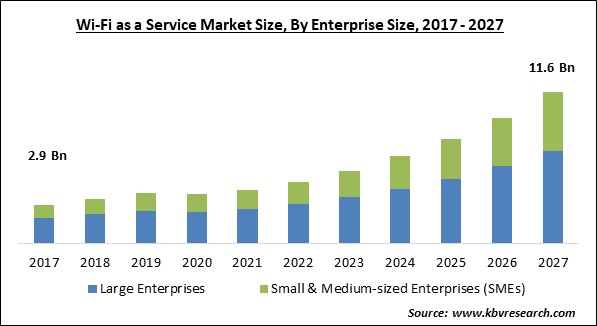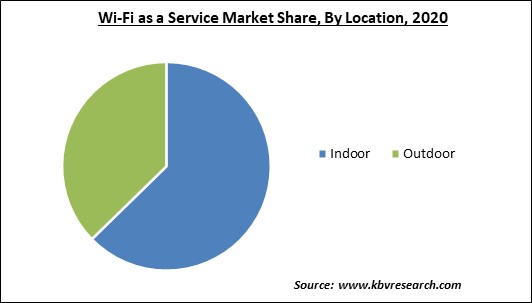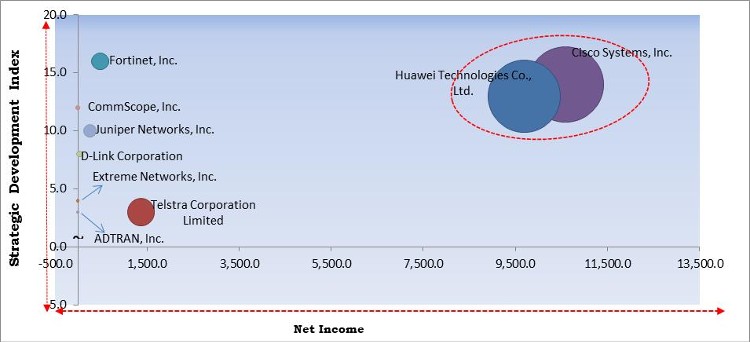The Global Wi-Fi as a Service Market size is expected to reach $11.6 billion by 2027, rising at a market growth of 19.0% CAGR during the forecast period.
Wi-Fi as a service is a cloud-based management system that enables enterprises with lesser IT resources to provide safe, reliable, and quick WLAN access over multiple locations. WaaS deployment is simple and quick because no cable installation is necessary, and it can be controlled through a network operating center, allowing smaller businesses to have a reliable and fast data network. Also, WaaS is perfect for temporary locations, heritage structures, and office relocations. In addition, WaaS includes advanced analytic capabilities that aid in the analysis of customer and employee behavior. WaaS also has an automatic system upgrade feature and it can offer secure guest access.
The expansion of smart cities, as well as the reduction in tariff rates for Wi-Fi equipment for organizations, ensures an efficient performance for the market. The rising demand for high-speed internet and comprehensive network coverage would give fuel to the overall market expansion over the forecast period.
Companies are now considering it as a crucial part of their operations, and they're not seeking for outsourced suppliers to ensure the elimination of risks and errors in the service quality. Wi-Fi has even penetrated into the domain of infrastructure overhead for some businesses, with IT staff opting to delegate control to professionals so they can emphasize on more strategic initiatives and operations.
WaaS was formerly called Managed Network Service. Wi-Fi-as-a-Service is a service that provides full turnkey design, management, and installation of all IT assets, including routers, servers, switches, firewalls, and others, to provide a Wi-Fi solution. WaaS can be used to meet a wide range of business requirements. It can also be utilized by enterprises with no existing Wi-Fi network as well as those with a network but are searching for a managed solution for a guest internet-only Wi-Fi network.

The COVID-19 outbreak is expected to have a significant influence on the expansion of the Wi-Fi as a service market. Due to the lockdown imposed across the world, the demand for Wi-Fi services has surged in most nations, owing to the growing tendency of people working from home. This has made a substantial contribution to the Wi-Fi industry's continued revenue generation, resulting in increased market growth. During the COVID-19 outbreak, the IT and telecom industries are playing a critical role in supporting governments' digital infrastructure around the world. Individuals and governments at all levels, such as federal, state, central, municipal, and provincial, have been in continual contact to provide and receive concurrent information on COVID-19. The healthcare, telecommunications, utilities, and government entities work tirelessly to stabilize the situation and provide essential services to all citizens.
Connected devices, digital solutions, and IoT systems are on the rise as a result of rapid technological breakthroughs. The increased acceptance of digital solutions is playing a major role in the development of wi-fi as a service sector. In addition, the increasing availability of smartphones would also play a role in the growing utilization of WI-FI as a Service. As the number of smartphone users grows, more people will be able to utilize their phones to interact with each other remotely for business purposes. Organizations all over the world are willing to deploy technologically advanced apps across their verticals in order to engage customers in new and engaging ways, necessitating the use of high-quality wireless network connections, such as Wi-Fi.
The rise of smart cities provides opportunities for suppliers of various technology and providers of related services. Increased government activities and growing public awareness of environmental issues have led to the creation of new solutions based on urban infrastructure development and design conceptual models. Smart city projects are becoming increasingly reliant on IoT, which includes new technologies, cloud, mobility, including data transmission, and sensors. Rapid and continual technological breakthroughs have enhanced internet connectivity, paving the way for the full development of these smart cities.
For businesses, maintaining the security and privacy of corporate data is crucial. Due to this, companies are hesitant to migrate their data and information to the cloud and rely on the conventional Wi-Fi network. Another important issue is natural or cyber-attacks that might destroy data centers, resulting in internet connectivity loss and thereby, disrupting numerous company processes. Data hackers can cause significant losses to organizations irrespective of their sizes. Due to the fact that WaaS is a cloud-based wireless internet service with increased connection delay, backups may take longer than with an in-house solution.

Based on Component, the market is segmented into Services (Managed Services and Professional Services) and Solution (Access Points and WLAN Controllers). In 2020, the solution segment procured the largest revenue share of the Wi-Fi as a service market. Unified Wi-Fi solutions allow SMEs as well as large enterprises to boost their productivity and mobility. In the solution segment, access points witnessed the largest revenue share of the Wi-Fi as a service market. Wireless gadgets, often known as smart devices, connect to any nearby network for internet connectivity via access points. Wireless Access Sites are another name for these points. The primary purpose of access points is to act as a conduit for wireless signals.
Based on Organization Size, the market is segmented into Large Enterprises and Small & Medium-sized Enterprises (SMEs). In 2020, the large enterprises segment captured the largest revenue share of the Wi-Fi as a service market. The growth of this segment is increasing due to the growing requirement to efficiently manage large and complex Wi-Fi network infrastructure. In addition, the growing adoption of Wi-Fi as a service among major businesses can also be attributed to the demand for improved network security.
Based on Location, the market is segmented into Indoor and Outdoor. In 2020, the outdoor segment registered a significant revenue share of the Wi-Fi as a service market. When Wi-Fi access is supplied outside of a building, it is referred to as outdoor Wi-Fi. It is used to provide consumers with continuous Wi-Fi access by extending an organization's internal wireless LAN network. It's employed in scenarios for school, college, university, Vacation Park, hospital, hotel, or retail center outside spaces.
Based on End User, the market is segmented into Service Providers, IT & Telecom, BFSI, Healthcare, Travel & Hospitality, Retail, and Others. In 2020, the service provider segment procured the largest revenue share of the Wi-Fi a service market. Consumer demand for bandwidth and the growth of internet users are estimated to propel the WaaS model's adoption among ISPs. Wireless infrastructure is being adopted by telecommunications companies to improve connection and enable users to seamlessly connect to their networks.
| Report Attribute | Details |
|---|---|
| Market size value in 2020 | USD 3.8 Billion |
| Market size forecast in 2027 | USD 11.6 Billion |
| Base Year | 2020 |
| Historical Period | 2017 to 2019 |
| Forecast Period | 2021 to 2027 |
| Revenue Growth Rate | CAGR of 19% from 2021 to 2027 |
| Number of Pages | 336 |
| Number of Tables | 613 |
| Report coverage | Market Trends, Revenue Estimation and Forecast, Segmentation Analysis, Regional and Country Breakdown, Competitive Landscape, Companies Strategic Developments, Company Profiling |
| Segments covered | Component, Organization Size, Location, End User, Region |
| Country scope | US, Canada, Mexico, Germany, UK, France, Russia, Spain, Italy, China, Japan, India, South Korea, Singapore, Malaysia, Brazil, Argentina, UAE, Saudi Arabia, South Africa, Nigeria |
| Growth Drivers |
|
| Restraints |
|
Based on Regions, the market is segmented into North America, Europe, Asia Pacific, and Latin America, Middle East & Africa. In 2020, North America acquired the largest revenue share of the Wi-Fi as a service market. The increasing growth of the market across the region is attributed to the growing number of large enterprises across the region. Moreover, the increasing number of market players in the field of digital device manufacturing is another reason that is accelerating the growth of the regional market.
Free Valuable Insights: Global Wi-Fi as a Service Market size to reach USD 11.6 Billion by 2027

The major strategies followed by the market participants are Product Launches. Based on the Analysis presented in the Cardinal matrix; Cisco Systems, Inc. and Huawei Technologies Co., Ltd. are the forerunners in the Wi-Fi as a service Market. Companies such as Telstra Corporation Limited, Juniper Networks, Inc. and Fortinet, Inc. are some of the key innovators in the Market.
The market research report covers the analysis of key stake holders of the market. Key companies profiled in the report include Cisco Systems, Inc., Fortinet, Inc., Huawei Technologies Co., Ltd., Telstra Corporation Limited, Juniper Networks, Inc., Extreme Networks, Inc., ADTRAN, Inc., CommScope, Inc., Tata communications limited (Tata Group), and D-Link Corporation.
By Component
By Organization Size
By Location
By End User
By Geography
Our team of dedicated experts can provide you with attractive expansion opportunities for your business.

